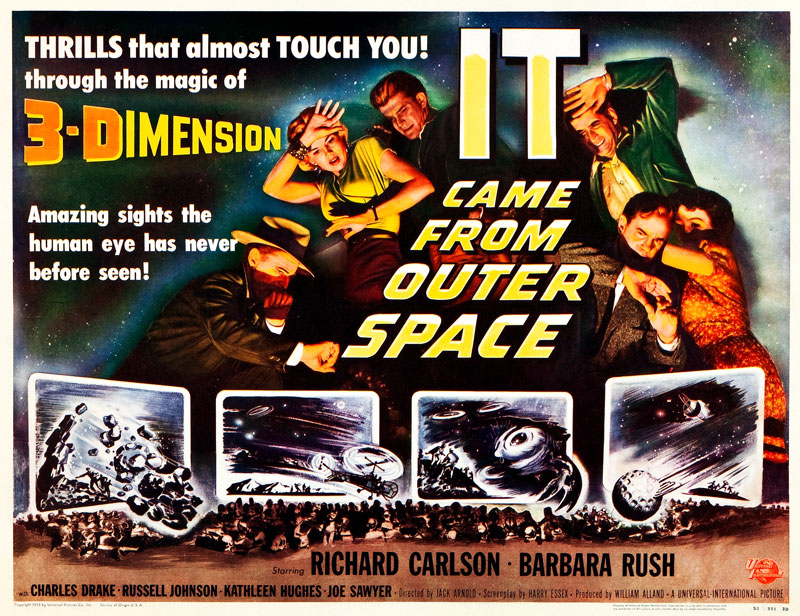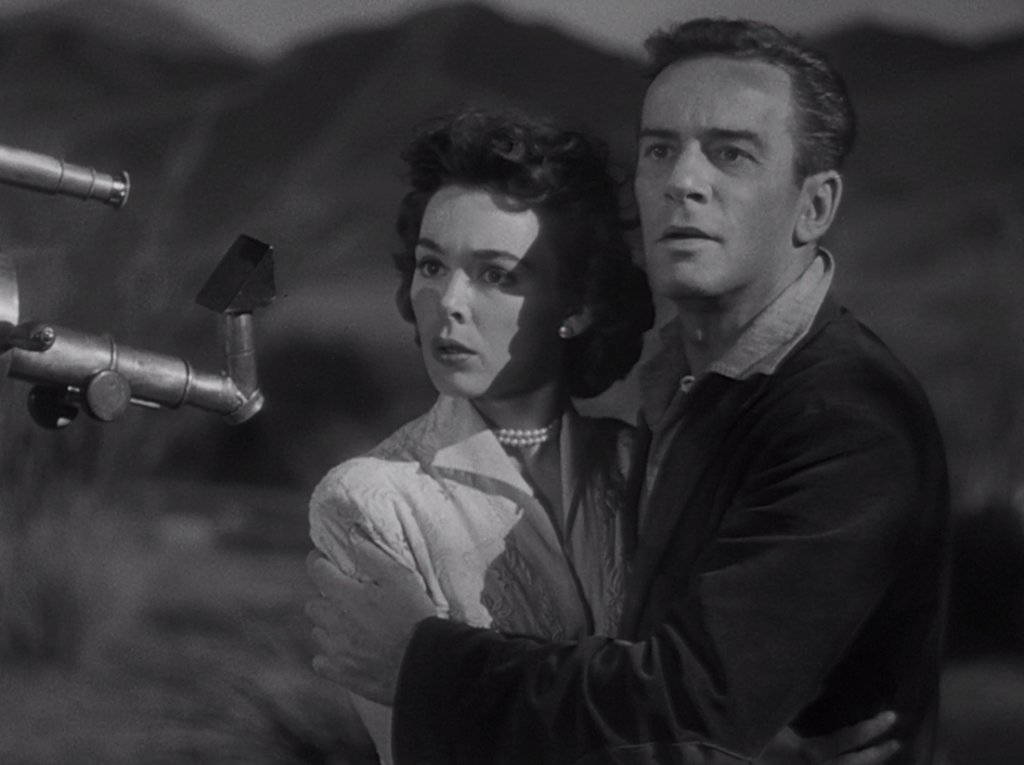
“I’m sorry. We did not want to use violence. Now there is no other way.”
It Came from Outer Space (1953) was the first 3D film from Universal-International Pictures, released just eight months after the film that kicked off a surge of renewed interest in the format, Bwana Devil (1952). Former documentarian Jack Arnold directed, and in short order became Universal’s go-to director of 3D thrillers with The Glass Web (1953), Creature from the Black Lagoon (1954), and Revenge of the Creature (1955), before the format went dormant once again and Arnold transitioned to 2D for films that included the 50’s SF gems Tarantula (1955) and The Incredible Shrinking Man (1957). I first became aware of It Came from Outer Space through a VHS tape I received as a Christmas present sometime in the 80’s. It was the first home video I owned; just having something with box art made it something special, and I watched it many times, along with The Thing (from Another World) and King Kong – the other two videos soon added to my collection. As a kid, at first I wasn’t aware that the film was originally made in 3D, though it would have explained a lot, like the way the titles launched toward the viewer at the start of the film, along with the alien’s fiery meteor of a spaceship. To watch 3D at home in the 80’s meant waiting for a special broadcast of a movie (say, 1961’s The Mask with a bonus Three Stooges 3D short) in red and blue anaglyph, begging your parents to pick up the station’s promotional 3D glasses at the local 7-11 and then, finally, squinting through the glasses at the TV and feeling betrayed that very little of it looked three-dimensional at all.
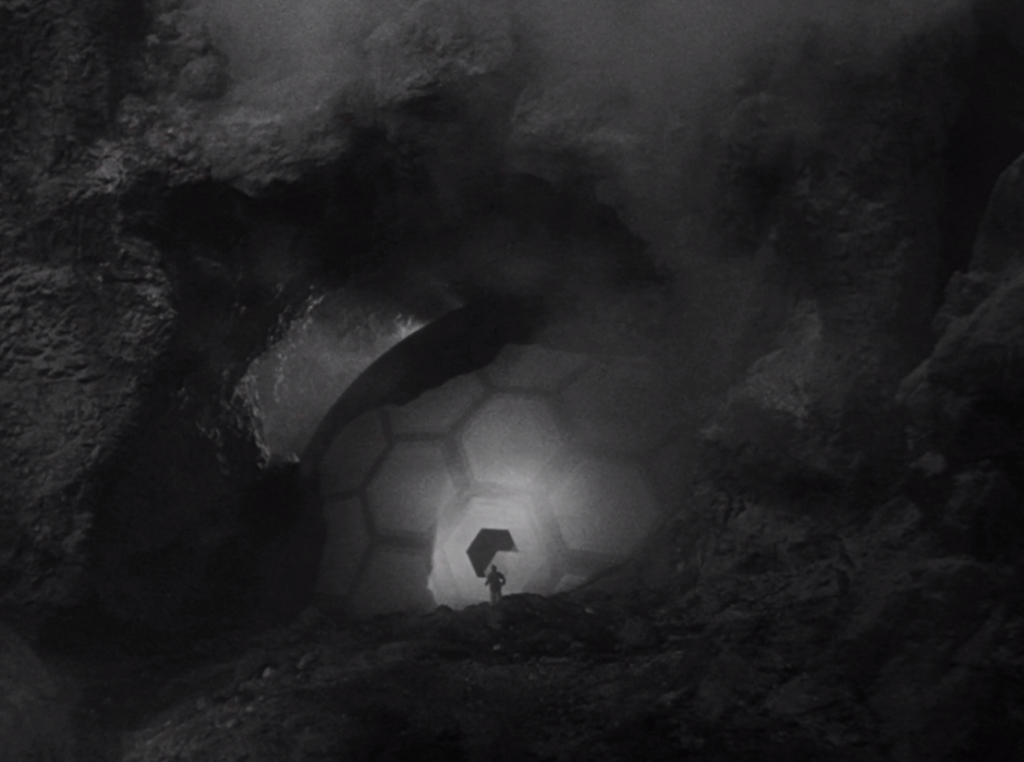
Discovery of the alien spacecraft.
Thanks to the 2016 3D Blu-ray release of the 3-D Film Archive‘s restoration of It Came from Outer Space (which corrects vertical alignment issues baked into the film), it’s now possible to see the movie the way it was intended. And I realize – having watched it this way for the first time last night, and comparing it to Creature from the Black Lagoon which I viewed last week in polarized 3D – that Arnold directed my favorite kind of 3D film. The coming-at-ya effects are used very sparingly, but effectively. In Creature, there are a few moments with the creature’s claw, whether real or fossilized, floating closest to the viewer, along with the odd speargun fired at the camera. But what I love the most about the 3D Creature is the lagoon itself, with its ripples of water receding further and further back and creating a breathtaking feeling of depth. (I prefer this to 3D films that render actors and objects as two-dimensional figures standing at different depths on a puppet stage.) It Came from Outer Space in retrospect feels like a dry run for Arnold’s more sophisticated use of 3D in Creature, but it’s nonetheless impressively designed, taking advantage of its vast desert location with its cacti, tumbleweeds, and Joshua trees. And there are moments, so valuable in 3D features, where the effect is applied as another color in the filmmaker’s palette, creating a sensation that suits the story – most notably in a scene where the main character, exploring an abandoned mine, suddenly realizes that he’s about to take a neck-breaking fall through a crevasse; he looks down and the plunge is delivered with a vertigo that only the 3D format can achieve. That sense of danger was never present when I watched it flat.
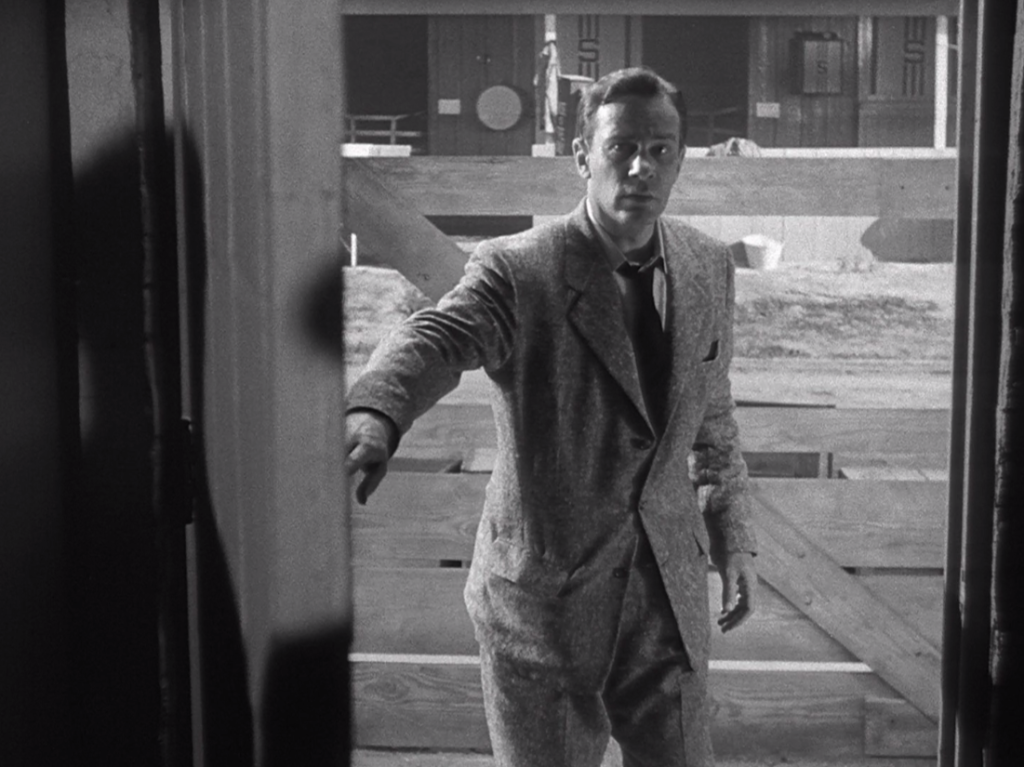
Richard Carlson as John Putnam.
Future Creature star Richard Carlson is the appealing protagonist, amateur astronomer John Putnam, who, as the story begins, is boasting to his girlfriend Ellen Fields (Barbara Rush, When Worlds Collide) that he’s just sold an article to a publication, and can therefore buy an addition to his house. Perhaps this is the film’s science fiction element? But no, moments later he’s looking through a telescope (swinging it over the audience’s laps) and spying what appears to be a meteor crashing into the Arizona wilderness. Driving out to investigate, he decides to get a closer look by dangerously descending into the crash crater. There he stumbles upon a dome-shaped object with a honeycomb-like pattern and an open door, beyond which is…something moving in the darkness. Then the portal closes, and the discovery is buried beneath an avalanche of rocks. Already we’ve been witness to some of Arnold’s most effective uses of the format. When we see the spaceship door first open before John arrives, the camera creeps slowly toward the shadows until our eyes fix on the objects inside – there’s a sense of genuine awe using very little but darkness, pinpoints of light, and 3D depth. Then Arnold, as he will do throughout the film, takes on the perspective of the alien rather than allowing us to view it directly, and mimics its cyclopean stare in a shimmery, rippling circle. (When we do finally see it, it’s a faintly ludicrous creation spitting fog from its one-eyed gelatinous head.)
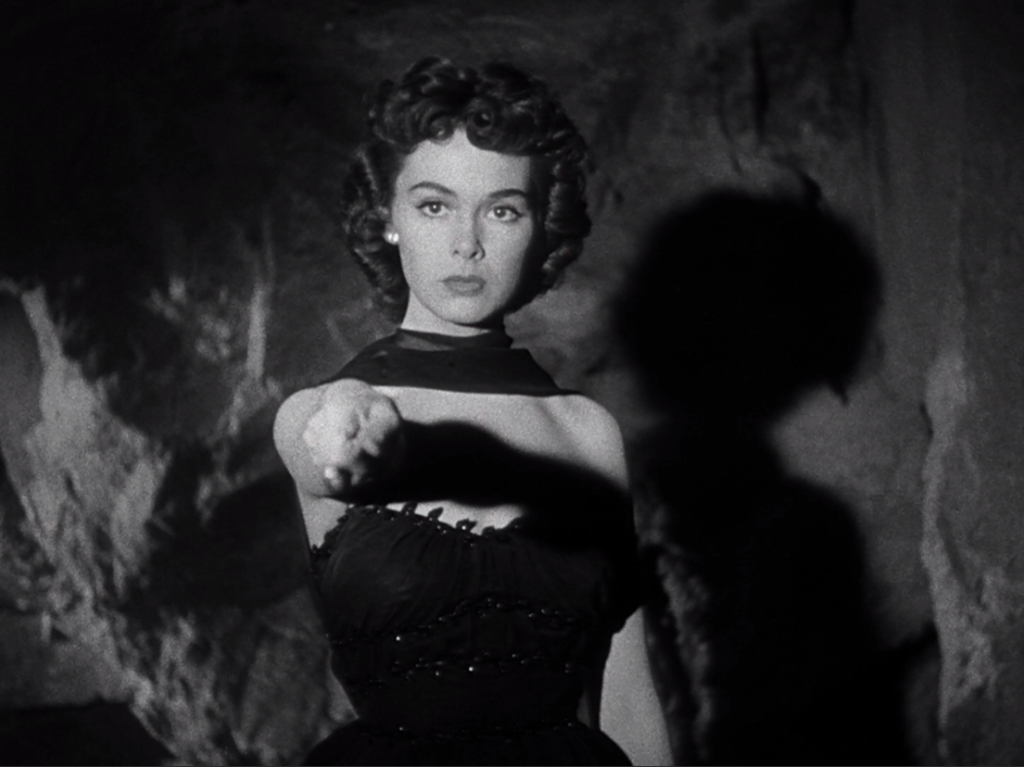
An alien visitor impersonating Ellen (Barbara Rush).
Following a treatment by Ray Bradbury, the film now focuses on John’s increasing isolation. He has a whopper of an alien invasion story with no evidence and a skeptical public – including a very frustrated small town sheriff (Charles Drake, Winchester ’73). Yet strange happenings continue, including visitations on the empty desert highway from a phantom-like creature. Ellen becomes his only ally, and the two try to convince the sheriff that certain locals (including Gilligan’s Island‘s Professor, Russell Johnson) are being replaced by extraterrestrial impostors, the originals held hostage while the town is raided for materials to repair the spacecraft. So it beats Invasion of the Body Snatchers (1956) to the punch by a few years, but the best aspect of Bradbury’s story is the way the conflict between alien and Arizonian plays out, like a Cold War conflict between different cultures that are doomed to never understand one another. The creatures insist they’re benevolent and only wish to return home – yet they’ve kidnapped and aren’t above making threats, knowing how the humans would receive them in their true unearthly shape. Like the tales that would feature on The Twilight Zone, the conflict between these points of view becomes the crux of the story, culminating in John’s decision to trust the strong-arming tactics of the aliens, and the sheriff – finally believing John, but not cooperating – gathering a local militia to confront the invaders with force. Bradbury’s twist on the familiar alien invasion yarn is smartly observational, and gives the story a sense of timelessness. Together with the eerie stillness of the Arizona desert – this would pair splendidly with Them! (1954) – the strong and serious performances, and Arnold’s use of 3D to create a feeling of immersion, It Came from Outer Space is a fireball of 50’s SF.
